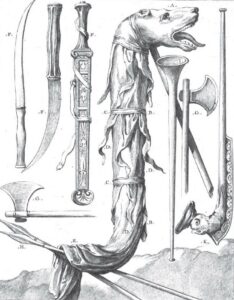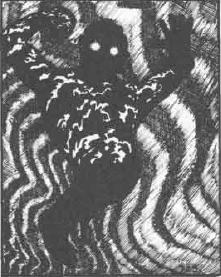
Dacian Draco weapons from Wikipedia
This is for a more complete alternate system that is in progress, but should also work with traditional D&D, clones, and simulacra. I know some people don’t like any kind of “roll for defense” mechanics, but these weapon abilities should still work minus the parry (which only comes up occasionally in any case). I’m still not totally sold on the parry mechanic myself; I believe it needs more play testing (but I am optimistic).
WEAPONS
All weapons do 1d6 damage. Some weapons have additional benefits, as described below. The anti-plate weapons should obviate the need for a weapon versus AC table.
Melee Weapons
- Spear: can be thrown, hold at bay, attack from second rank
- War hammer, military pick, mace: +2 against plate
- Dagger: can be thrown up to 50’, concealable, auto-hit grapple
- Axe: re-roll damage of 1, may attack shields directly (and destroy them)
- Sword: draw and use in same round, allows one riposte
- Two-handed sword: 2DTH
- Javelin, can be used as a melee weapon, longer range than dagger or spear
- Pole arm: hold at bay, 2DTH, -2 when not attacking from the second rank
- Quarterstaff: one free parry vs. melee weapons
- Lance: 2d6 damage when mounted and charging
Missile Weapons
- Bow: one shot per round, better range than anything thrown
- Crossbow: +2 vs plate, one round to reload
- Sling: light, cheap ammo
DEFINITIONS
- 2DTH: roll two dice and take the highest for damage.
- Riposte: if an enemy misses you with a melee strike and rolls 5 or less on the attack roll, you get a free counterattack.
- Parry: make a saving throw versus paralyzation to deflect an attack that hits.
- Hold at bay: attacker must make a save to attack you, upon failure you get a free counterattack.
PARRY
Rather than make an attack, characters may choose to focus on defense. This is called “parrying” but should not be thought of as a single block or deflection (any more than a sword attack is a single cut or thrust). Any character may parry, but must be wielding a weapon or holding a shield in order to do so. Parrying allows you to make one saving throw versus paralyzation to avoid what would otherwise be a successful melee attack. Characters trained in unarmed combat may elect to parry even if not using a weapon or shield. Using a shield also grants you one free parry per turn (this may be used any time before the beginning of your next turn), and unlike standard parrying, shields may also be used to parry missile attacks. Quarterstaffs also allow one melee parry per round in addition to an attack (though note that a quarterstaff requires two hands to wield). No more than one parry may be attempted per turn.
HOLD AT BAY
Usable in place of a standard attack, must target one enemy, no attack roll, usable with spears, tridents, and similar weapons. If enemy attacks the spear wielder, enemy must save versus paralyzation or fail in the attack and be subject to a free attack from the spear wielder. Creatures bigger than large size require multiple spear wielders to be kept at bay.
Thanks to the people on G+ who contributed to the discussion that led to these rules, first here back in May and then here yesterday. Also see The Dragon’s Flagon regarding a similar (but slightly more complex) system for holding enemies at bay with pole arms. The flail is intentionally omitted, though if I did include it I would have it bypass shields and have a bonus to disarm.








